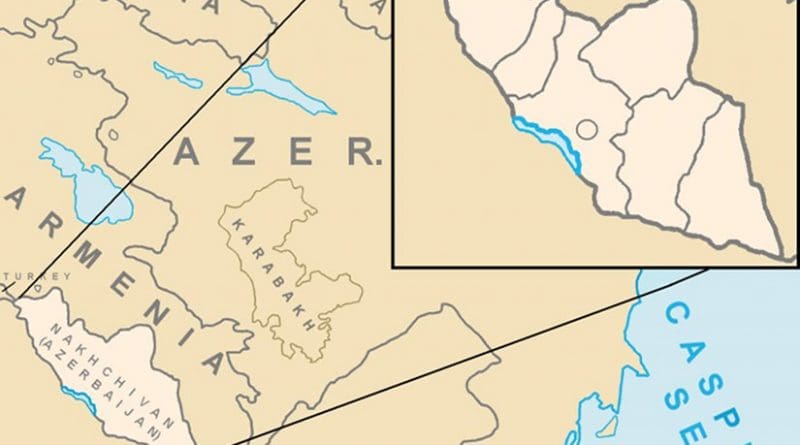Nakhchivan Sacred Monuments: Welcome International Experts – OpEd
By Peter Tase
The cultural treasures of the Autonomous Republic of Nakhchivan, one of the most important provinces of Azerbaijan, unfortunately have been ignored for a long time by a number of International institutions that focus on Culture, Science and Education, such as UNESCO and others.
The decades long discovery of sanctuary parks, archaeological landmarks and sacred places in the region of Sharur, make the territory of Nakhchivan a fertile soil of archaeological discoveries and a formidable place to study the Bronze Age; where UNESCO experts, among others, can conduct research that may provide answers to many unresolved questions of our ancient past.
Some of the cultural heritage sites of high value are the Aghzirat Sacred Place, Akhamat and the Aghsal Necropolis.
The Sanctuary of Aghzirat is located to the east of Yukhari Yayji Village, in Sharur Region, located under a rock that is a natural cave that has been studied extensively by local scientists. Visitors can reach the natural monument, through a small passage from the north side. Such a monument is also considered by the locals as a sacred place that embodies a number of ancient legends that make this region to grow closer to a series of heavenly miracles that have occurred in ancient times. Inside the natural rocky area, pilgrims visit periodically every year to honor the memories of a civilization that continues to have many undiscovered aspects. According to the Encyclopedia of Nakhchivan Monuments, “pilgrims bring candles and place them in small stony stands around the cave and continue with their prayers.”
Azerbaijani archeologists have discovered many archaeological items, ceramic and pottery pieces in the Aghzirat Sacred Place; they have uncovered a lamp that dates back in the Middle Ages and numerous ceramic pieces inside the cave and in its surroundings. On the lower level of Aghzirat is a natural cave where visitors will enjoy constant water drops and in front of it, they will be greeted by a divine mulberry tree. This is perhaps one of the very few archaeological sites of Azerbaijan that has a sacred tree in its surroundings. The water drops in this sanctuary are considered to be sacred. On one of the stones near the sacred place there are seven traces that are shaped like a horse foot, each one of them. The local observers call it as the stone of “horse feet”.
According to the legend, the local fighters, in ancient times, had visited the cave of Aghzirat to pray, when the enemy was overwhelming, was in larger numbers and fast approaching, in this occasion the local warriors prayed to God in order to transform their female companions into stones in order to avoid them from being hostages taken by the invading forces. In this occasion the enemy forces entered the cave faced with many “people” turned into stones, this is the reason why people today visit Aghzirat and pray for their wishes to be fulfilled as well as throw a stone to one of the ‘woman’ stones that surround this sanctuary, in hopes for luck. Even though the discovered ceramic items belong to the Middle Ages, the monument of Aghzirat Sacred Place belongs to the Bronze Age in Azerbaijan; there is also ample evidence that affirms the existence of this sanctuary since the III-II Millennium BC.
Aghsal Necropolis is another unique archaeological monument that dates back to the Bronze Age. It is situated in the North East side of Milakh Village, on the banks of Alinjachay, within the Julfa territory. According to archaeologists A. K. Alakbarov and O. H. Habibullayev, there was a big necropolis where many tableware and clay items have been found. In the Banks of Alinjachay there is a sector that contains a large amount of archaeological treasures that could serve to the further study of ancient culture of the Caspian region and provide new research results on the agricultural tools of the Bronze Age and human lifestyle in that period. Many archeological items and structures in this area of Nakhchivan, await the visit of international experts, who specialize in the study of the Bronze Age and early antiquity.
In the south west side of Akhamat village (Sharur Region) is located the Akhamat Settlement that was built in the First Millennium BC. During the periodic excavations there were discovered big stone structures, agricultural labor tools made by stone, a grain grinder made by stone, as well as rare ceramic objects. In 2001, there were undertaken a series of investigations in the area and many unusual clay items were found. These ancient materials provided new clues on the culture, evolution of ethnographic processes and tools of agricultural sustenance in Azerbaijan.
Archaeologists of Nakhchivan have been able to discover many important items whose importance crosses frontiers and countries, meanwhile international organizations, UNESCO and other structures of United Nations have not paid serious attention to this part of the world that happens to be in the heart of ancient trade routes and of many ancient battlefields where armed clashes are felt until the present.

